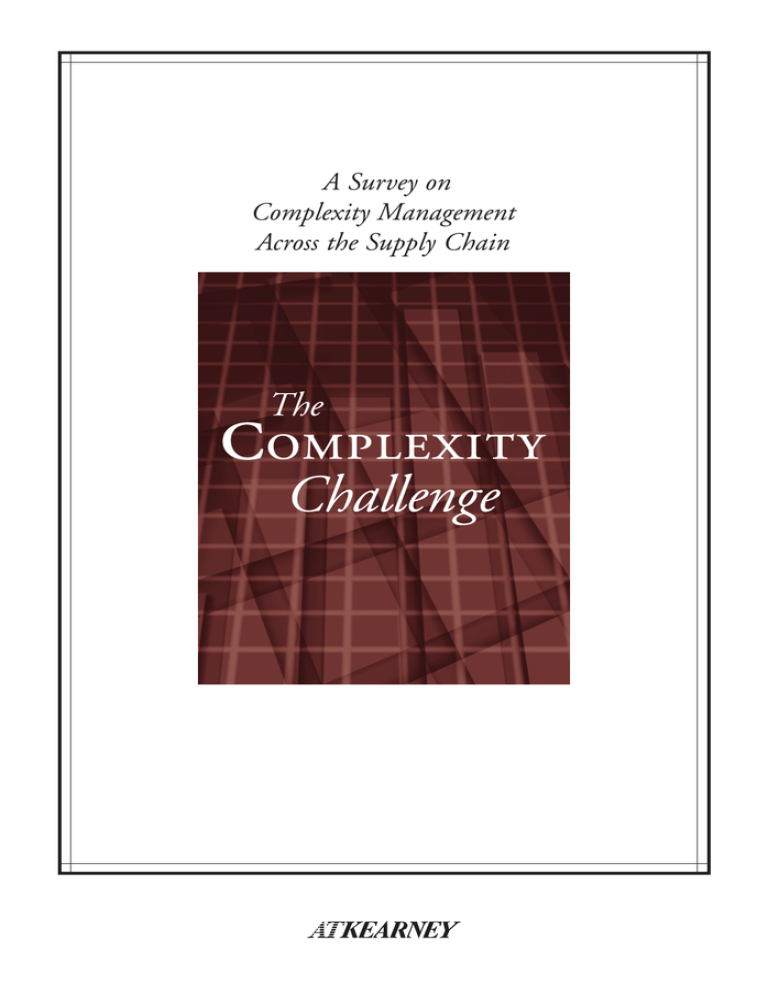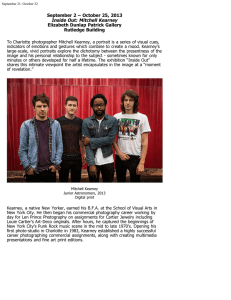
A Survey on
Complexity Management
Across the Supply Chain
The
Challenge
Introduction
Anyone who has visited a supermarket or mass merchandiser recently appreciates the explosion in
the variety of products. Consumer product manufacturers have added brands, extended lines and
altered pack sizes, shapes and colors to encourage more consumers to open their wallets. In 2003
alone, nearly 27,000 new food and household products were introduced, including 115 deodorants,
187 breakfast cereals and 303 women’s fragrances.1
In introducing these new products — and variations on existing products—companies have made
their businesses more complex. Designing, marketing, forecasting, pricing, producing and distributing a growing legion of unique SKUs (stock-keeping units) drives up costs, increases the risk of
lost sales (due to out-of-stocks) and dilutes management attention. Add to this the uncertainties
about why, when and how to add a new item or prune an existing product line, and the complexity
challenge balloons further.
Given this increased level of complexity, A.T. Kearney undertook a study on complexity management,
which captured the experiences of executives at more than 30 leading consumer products manufacturers in North and South America. The study components included a web-based survey, select
follow-up interviews, and an executive roundtable in which participants discussed their experiences
in complexity management.
This paper summarizes the findings from the research and the additional perspectives gained from
the roundtable discussions.
1
The Global New Products database compiled by Mintel International Group Ltd. Discussed in “The Vanishing Mass Market,” BusinessWeek, 12 July 2004.
The Complexity Challenge
What should executives at consumer products
manufacturers know about complexity and how
should they prepare their companies to manage it
better? Based on our recent research, A.T. Kearney
offers the following three messages:
1. Increased complexity is almost inevitable
as companies pursue business growth. Growth—
the “holy grail” of business—means increased
complexity for most companies. Organic growth
usually means more products, markets and channels. Growth via mergers and acquisitions compounds complexity. Indeed, a robust 88 percent
of survey participants note that their business has
grown more complex over the past half decade,
and 79 percent expect further increases in complexity over the next five years. Complexity is here
to stay; companies must learn to address it.
2. Tomorrow’s focus must be on complexity
management, not simply complexity reduction.
Most companies focus on tactical complexity
reduction (for example, eliminating slow-moving
SKUs). Few think about strategic complexity
management: how to achieve and maintain
profitable growth by only adding complexity
where it counts (for example, providing consumers with the right product variety), while
constantly driving unnecessary complexity out
of the business.
3. There is a path toward effective complexity management. Although no single company
in our research has completely “cracked the code”
on complexity management, several report significant progress. The research distills their experiences and knowledge into six key practices for
managing complexity effectively.
Figure 1: Balancing value and cost
:
Achieve profitable growth by managing
complexity trade-offs better than competitors
Value from market-facing
complexity
• Understand how go-tomarket decisions such as
product offering, customers,
markets and channels affect
complexity
• Make the right tradeoffs on market-facing
complexity
• Mitigate the effects
of complexity through
operations and organizations
Source: A.T. Kearney
..
Costs of operating and
organizational complexity
• Understand how operating
and organization decisions
affect complexity
• Understand how these
decisions enable the company to take on greater
market-facing complexity
The Complexity Challenge
For companies intending to grow through new
products and extended product lines, complexity
will always creep in. Complexity is a natural byproduct of adding categories, shortening product
lifecycles, and accelerating product introductions.
Similarly, growth via markets and channels brings
with it such complicating factors as tailored
service offerings, customer-mandated requirements and SKUs that are specific to individual
markets and channels. In fact, the increasing
competitiveness of the retail industry is challenging leading operators to differentiate their
business from their peers, which often translates into greater complexity for the consumer
products manufacturer. In addition, mergers
and acquisitions boost complexity as the newly
formed company works to rationalize assets and
product lines, integrate systems and processes,
and bring increased harmony to policies, cultures
and behaviors.
Growth is not the only reason for increased
complexity, however. Feisty new competitors,
advances in technology, concerns over consumer
health and safety, government requirements and
restrictions (such as product labeling), risks that
can disrupt a business (such as natural disasters,
labor unrest and terrorism) and industry consolidation all add to complexity.
A company’s approach to internal operations
can help dampen complexity or exacerbate it.
For example, companies that more readily absorb
complexity are those with flexible production
assets, common components and ingredients, and
consistent operating processes across locations.
Organizational structures and incentive and
reward systems can encourage and enable crossfunctional collaboration—but again, if improp2
erly designed, can thwart it. In contrast, decisions
to outsource can create new kinds of complexity
as companies must manage new relationships and
deal operationally across company boundaries.
If complexity is here to stay, and a growing
force, how should a company manage it? The
first step is to understand that complexity is not
necessarily a pejorative term. Simply focusing
on reducing complexity is a mistake. There is
such a thing as good complexity for consumer
products companies—complexity that is necessary and value adding. And just like with good
and bad cholesterol, companies need to treat
good and bad complexity differently.
Sometimes complexity can help a company
gain market share and boost the top line, as when
consumer products companies employ promotional packaging and brand extensions or increase
product assortments. But, as Barry Schwarz points
out in his book, Paradox of Choice, too much
variety can confuse and frustrate consumers.2
The burdens of complexity result from
negative phenomena such as unchecked SKU
proliferation, small batch runs and the loss of
procurement leverage as purchase quantities
dwindle. The challenge becomes one of balancing value and cost— that is, making the right
complexity trade-offs to add good complexity
in pursuit of growth, while mitigating the effects
of bad complexity on operations and organizations. In other words, companies should aim to
reduce the cost of good complexity and the level
of bad complexity (see figure 1).
Achieving the balance between value and cost
is crucial. Nearly one-third of the consumer products manufacturers in our survey acknowledge
Barry Schwarz, Paradox of Choice (Ecco, 2004).
..
Tomorrow’s focus must be on
complexity management, not
simply complexity reduction.
The Complexity Challenge
that they chase revenue growth without adequate regard for long-term profitability. An alltoo-common approach is to chase new business
first, with the expectation that the business can
be made profitable down the road.
Managing complexity requires both strategic decisions and remedial actions (see figure 2).
In the initial stages, a company may indeed look
to reduce complexity by streamlining its current
products and supply chains. But an active,
ongoing strategic decision-making process is
necessary to ensure that the pursuit of growth
only adds necessary complexity. Otherwise the
situation becomes, as one of our roundtable
executives pointed out, “Like your basement or
garage. Over time you accumulate ‘stuff,’ or
complexity, and it is not until the basement is full
of non-value-adding junk that you step back and
decide you need to clean things up by having a
yard sale.” The challenge in business, of course,
is to ensure that you never start accumulating
unnecessary junk. Research by A.T. Kearney and
others has found that there is a positive correlation between financial results and performance
on key complexity management activities such
as those listed in figure 3 on page 6. Yet, as the
figure indicates, few of the executives in our
research group rate their companies as more
effective than their competitors in these areas.
Most companies fall short in multiple areas; only
28 percent of participants rated their companies
as ahead of the competition on six or more
Figure 2: Complexity management requires strategic decisions and remedial action
Understand value of
market-facing complexity
Design future marketfacing complexity
based on strategic
positioning and longterm profit potential
Select right operating
practices to meet
requirements
Rationalize existing market-facing
complexity based on profit potential
Understand operating
requirements and constraints
Align or create
new capabilities
to accommodate
market-facing
complexity
Explore other ways to
improve profitability
Eliminate operational complexity
that does not add value
Embed improvements
in future capabilities
Source: A.T. Kearney
..
The Complexity Challenge
of these activities. It appears there is considerable room for improvement through more robust
approaches to complexity management.
A.T. Kearney’s current research focuses on learning how leaders successfully manage complexity.
How do they determine the marketplace value of
complexity? How do they manage the trade-offs
of additional market-facing versus operational
complexity? How do leaders decide where to
start and where to focus?
Our findings indicate that success stems
from strategic decision-making and improved
capabilities. The former refers to the processes
and information that leading companies have in
place to make the right trade-offs and exploit
capabilities quickly, while the latter refers to the
ways in which leaders maintain a continuous
focus on improving key operational capabilities
to effectively manage complexity.
From our analysis, we have determined that
six characteristics, common to all leaders, will
help to effectively manage complexity:
• Understand the requirements of customers and
consumers
• Make trade-offs based on an understanding of
the cost effects of changes
• Eliminate over-specification and complexity
creep in design and development
• Align goals and objectives at the executive level
Figure 3: Few manage operational complexity well enough to claim it is a competitive advantage
Eliminate non-value-adding steps with customers…
90%
35%
…Internally
86%
30%
…With suppliers
40%
Share supply chain information with suppliers…
30%
…With customers
30%
…Across departments
30%
86%
90%
86%
81%
Standardize requirements, reduce suppliers
90%
45%
Build in supply chain flexibility
35%
86%
Standardize manufacturing and distribution process
40%
81%
Use supplier knowledge to reduce complexity
40%
81%
Percent of respondents
Action is important or critical to effective complexity management
Company performance is “more” or “significantly more” effective than competitors
Source: A.T. Kearney 2004 Complexity Survey
..
The Complexity Challenge
• Provide visibility into complexity levels and
required trade-offs
• Develop and leverage new capabilities on a
continuous basis
Understand the requirements of customers
and consumers
Our survey respondents agree that understanding the requirements and other factors that
drive buying decisions of current and potential
customers and consumers is important — often
critical. The challenge lies in understanding
value-added complexity. Value-added complexity is any product or service differentiator that
the customer is willing to pay for. A customer in
a large city may be willing to pay for standard
food items in smaller quantities, such as a fourpack instead of a six-pack, for ease of carrying
and storage. But a customer is less likely to pay
more for different packaging that denotes a different flavor if that same information is already
on the label. An example is peanut butter or soft
drinks that have different cap colors denoting a
different texture or flavor.
Similarly, the buying and switching behavior
of both the consumer and the retailer is an
important factor to consider. For example, if a
new product is added to a line, does it produce
real growth or merely cannibalize existing sales?
If an item is discontinued, do sales shift to other
products from the same brand or company or to
competitors? By using techniques such as “design
of experiments”— a systematic approach to examine the effects of numerous variables — in test
markets, companies can model the effects of
these decisions on a sample basis.
Also, a clear distinction needs to be made
between complexity that is added to meet retailer
requirements and added complexity that delivers
value to the consumer. In a surprising number
of cases it is actually the retailer that adds complexity. One roundtable participant recounted
an example of some retailers deliberately requiring different packages for identical products,
making it more difficult for consumers to comparison shop. Another roundtable participant
sold products to a fast food franchise that dealt
largely with perishable foods. This customer
had a blanket requirement that goods must be
received with 80 percent of their shelf life
remaining. For perishables and fresh foods this
was a sound policy, but for items with a threeyear shelf life, this stipulation made no sense for
either customer or supplier.
Make trade-offs based on an understanding
of the cost effects of changes
When increasing or decreasing market-facing
complexity, companies also need to consider
how these changes will affect cost areas such as
marketing, operations, SG&A (sales, general and
administration) and other internal areas. Among
the participants in our research, 82 percent said
that estimating the cost effect on these areas was
critical or important to effectively manage complexity. Yet only 33 percent believed they were
more effective than competitors in doing so. In
our experience, only a handful of companies
know the key cost sensitivities involved as their
product portfolio becomes more complex.
Understanding how costs behave provides
the basis for estimating the impact of change. It
is crucial to track and tie each cost to its source,
whether the source is an individual customer,
a broad customer segment, a certain product,
a specific channel or some other factor. It is
equally important to consider how changes fit
with the business model and how they will
..
The Complexity Challenge
affect each internal area: Will the change help to
gain or reduce manufacturing scale economies?
Will it add or reduce risk? Will it require a
change in investment levels? How will it affect
predictability? A deep understanding of cost
behavior — both for current costs and under
potential scenarios—gives a platform from which
to estimate the resulting effects on profitability
levels. This requires both tools and thought that
transcend traditional activity-based costing.
One roundtable participant explained how
his company manages product additions by
making marketing people accountable for product profitability. Much like justifying a capital
investment, product managers prepare a 10-year
financial plan, including a profit-and-loss statement and balance sheet. Included in the plan
are budgeted marketing funds. Progress is tracked
and additional marketing funds are made available for products that exceed profit goals.
Products that don’t perform well must deliver
targeted profits—potentially by cutting out costs,
including marketing funds—or be discontinued.
In addition to driving financial performance,
the company also uses the process to reveal and
understand the root causes that drive performance higher or lower than the plan. Through
these tight controls, the company’s approach is
both Darwinian (“to not keep funding the dogs,”
and instead feed successful products) and insightful (learning from past successes and failures to
make better decisions next time).
Eliminate over-specification and complexity
creep in design and development
More than two-thirds of our study participants
consider it critical or important to design complexity out of their products by eliminating overspecification in design and by reusing designs
and standardizing modules where possible. Yet
only 20 percent of these companies believe they
are better than competitors at these actions.
A useful way to think about product complexity is in terms of “at the skin” versus “below
the skin” product simplification. “At the skin”
product and packaging characteristics are those
that are discernible to the customer, such as the
basic look, feel or taste of the item, and the size,
shape and color of its package. As these can affect
buying decisions, a product’s key differentiating
attributes need to be identified and specified
appropriately at the design phase, while other
attributes should be standardized where possible.
On the other hand, “below the skin” complexity refers to raw material, component and
packaging standardization that specifically targets efficiency improvement without introducing customer- or consumer-discernible changes.
These considerations simplify the decisionmaking process around complexity, especially
for those features that do not affect the consumer’s buying decision.
A prime example of complexity creep was
illustrated by one of the roundtable participants.
As a manufacturer of various food products
across multiple business units, the company
did not previously monitor ingredients being
specified for its products. As a result, 131 different specifications for onions—several onion
varieties, each with form, shape and size differences—were used across the company. After an
aggressive rationalization, the number of unique
specifications was reduced to 21.
Align goals and objectives at the executive level
All executives in our study agree on the importance of aligning goals and objectives at the
executive level to help the organization work
..
Complexity management is not
a supply chain issue, nor a marketing, design or financial issue.
It is a business issue.
The Complexity Challenge
together to manage complexity. And it is crucial
to sustain the complexity management balance
as the product portfolio evolves. Yet just 40 percent believe they have a competitive advantage
in this area.
Goal alignment is relatively straightforward
when an organization takes on a major corporate
initiative. For example, one company established
a separate project team aimed at four objectives:
eliminating non-value-added complexity, harmonizing its portfolio, finding synergies across units
on ingredients and packaging, and putting in
place a self-sustaining process.
The size of the opportunity helped gain
senior management buy-in and commitment.
By crafting the steering committee structure
and handpicking cross-functional team members,
the company made considerable progress on the
first three objectives. The challenge still facing
this company— and the other roundtable participants— is how to establish an organizational
structure and process that drives an ongoing program of complexity management. This requires
a lasting form of goal alignment, one that does
not dissolve when the program du jour ends.
Although no prescriptive answer emerged
from the roundtable discussions, what may be
needed is an integrated planning process for
complexity similar to the one used for sales
and operations planning by many companies.
A recurring theme in the roundtable discussions
was that complexity management is not a supply
chain issue, nor a marketing, design or financial
issue. It is a business issue. To manage complexity
on an ongoing basis requires a common language
for complexity, the opportunity and forum for
cross-functional discussion and a business-led
view of trade-offs and decisions.3
3
Provide visibility into complexity levels and
required trade-offs
The survey reveals that most respondents do
not have data readily at hand to manage complexity. For example, more than 40 percent lack
easy access to information on the true number
of SKUs in their product lines. Complications
include both cumbersome data availability (such
as multiple systems) and definitional issues (for
example, different, non-substitutable promotional packs that carry the same SKU code).
Based on the roundtable discussions, most
research participants believe improved analytical
tools are needed to easily access and mine the
data that is available. For example, they see the
need for better tracking, reporting and analysis
of the true sales effects of a product addition,
deletion or packaging change. Faced with factstarved decision-making, roundtable participants
described a typical internal debate: “The new
package was expected to boost sales by 6 percent. Sales only went up 4 percent. Was this a
failure? But if we hadn’t changed the packaging,
would sales have dropped?”
Better data availability also includes improving product data management capabilities on
the ingredient, formulation and packaging side.
Roundtable participants explained how product
researchers and designers add complexity by
re-specifying particular ingredients because they
do not have access to a catalog of previously
specified items.
Develop and leverage new capabilities on
a continuous basis
The final focus area is making sure the company
has the capabilities to take on increasing levels
of complexity at a reasonable cost, ensuring the
See “Learning a New Complexity Language,” A.T. Kearney Executive Agenda, First Quarter 2004.
..
The Complexity Challenge
achievement and sustainability of profitable
growth.
The first step is to exploit today’s “sweet
spot”— understanding current capabilities and
leveraging them when adding complexity to the
business. One high-volume manufacturer of consumer products has the capability to decouple
its packaging operation from the production
line, as opposed to its lower-volume competitors
that package in-line. Although this process results
in a higher unit cost, the increased flexibility
allows the company to quickly seize market
opportunities that require more packaging
variety— both item count and pack appearance.
By postponing final packaging and aligning it
with actual demand, the manufacturer is able
to offset the cost differential through greater
customer responsiveness and lower inventory
investment.
Companies also can improve their ability to
take on complexity through the following actions:
• Standardizing material requirements and reducing the number of suppliers to help ensure
consistency and quality of supply
• Standardizing manufacturing and distribution
processes to allow products to be made and
shipped from alternate locations
• Eliminating non-value-adding activities in supply chain processes with customers and suppliers
• Sharing information on usage, forecasts, capacity, inventory and shipments to customers across
internal departments and with suppliers
• Developing supply chain strategies that build
in flexibility and resiliency
But these are largely reactionary, incremental
improvements. For some companies, increased
complexity could sound the alarm to take bold,
strategic action. A future of increasing complexity could trigger a program of fundamental
business simplification. For example, rethinking
brand profitability, product families and production technologies could eliminate the need
for whole production lines or even whole plants,
or enable shifts to manufacturing technologies
with step-change cost advantages. This could
yield a significant competitive advantage in total
value chain cost.
..
Conclusion
In a global economy that offers a world of choices, business complexity will continue to increase
despite efforts to hold back the tide. While this may seem like bad news, companies that can successfully manage complexity will enjoy a distinct competitive advantage in their markets.
Those looking to gain an edge will do so through:
• Superior intelligence and insight on customers and consumers
• Complete, accurate and efficient decision tools
• Relentless elimination of unnecessary complexity in products and processes
• Continuous enhancement of complexity management capabilities
The key to successfully managing complexity may well lie in reducing the cost of necessary complexity
while simultaneously reducing the level of unnecessary complexity. Doing so requires not just a process,
but also a conscious cultural change that embeds these principles within the organization.
A.T. Kearney is an innovative, corporate-focused management consulting firm
known for high quality, tangible results and its working-partner style. The firm was
established in 1926 to provide management advice concerning issues on the
CEO’s agenda. Today, we serve the largest global clients in all major industries.
A.T. Kearney’s offices are located in major business centers in 34 countries.
| Atlanta | Boston | Buenos Aires | Caracas | Chicago | Dallas
Detroit | Los Angeles | Mexico City | Miami | New York | San Francisco
São Paulo | Silicon Valley | Stamford | Toronto | Washington, D.C.
| Amsterdam | Athens | Berlin | Brussels | Copenhagen | Düsseldorf
Frankfurt | Geneva | Helsinki | Lisbon | London | Madrid | Milan | Moscow | Munich
Oslo | Paris | Prague | Rome | Stockholm | Stuttgart | Vienna | Warsaw | Zurich
| Bangkok | Beijing | Hong Kong | Jakarta | Kuala Lumpur
Melbourne | New Delhi | Seoul | Shanghai | Singapore | Sydney | Tokyo
| Johannesburg
For information on obtaining additional copies, permission to reprint
or translate this work, and all other correspondence, please contact:
A.T. Kearney, Inc.
Marketing & Communications
222 West Adams Street
Chicago, Illinois 60606 U.S.A.
1 312 648 0111
fax: 1 312 223 6759
email: insight @atkearney.com
www.atkearney.com
Copyright 2004, A.T. Kearney, Inc. All rights reserved. No part of this work may be reproduced in any form without written permission from
the copyright holder. A.T. Kearney ® is a registered mark of A.T. Kearney, Inc. A.T. Kearney, Inc., an EDS company, is an equal opportunity employer.
5M
ATK804841




